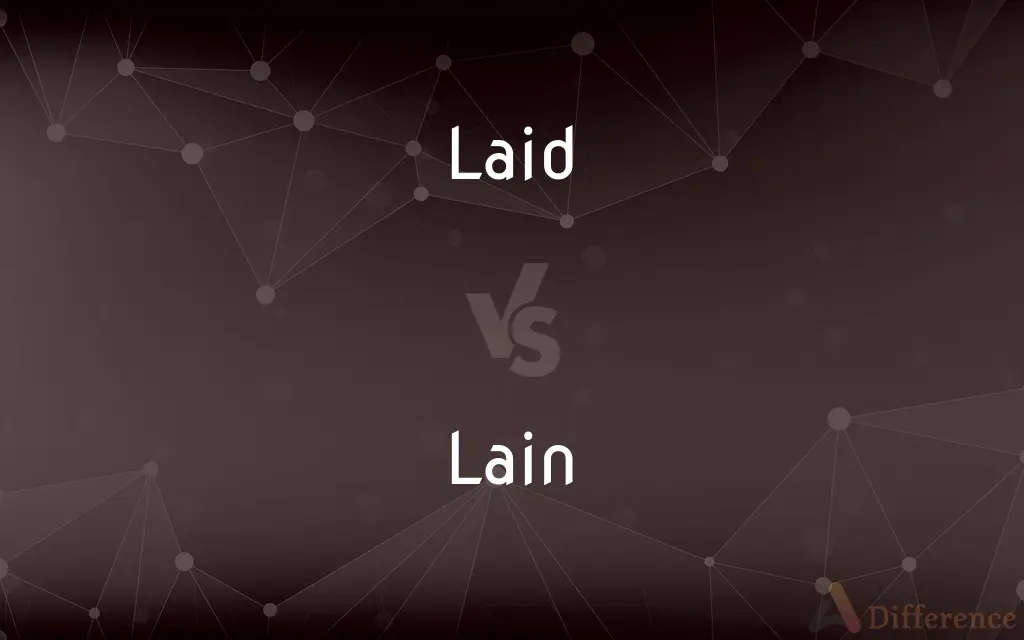Laid vs. Lain — What's the Difference?
Edited by Tayyaba Rehman — By Urooj Arif — Updated on May 8, 2024
"Laid" is the past tense and past participle of "lay," meaning to put something down, while "lain" is the past participle of "lie," referring to the act of reclining.

Difference Between Laid and Lain
Table of Contents
ADVERTISEMENT
Key Differences
"Laid" is used when referring to the action of placing or putting something down deliberately. Whereas "lain" is used to describe someone or something resting or reclining in a horizontal position.
For instance, you might say, "She laid the book on the table," indicating an action performed with an object.In contrast, "lain" is used without a direct object and focuses on the state of resting or being in a place. On the other hand, "I have lain on the bed all morning," suggests a duration of time spent lying down.
"Laid" derives from the verb "lay," which requires a direct object, meaning it is transitive. Whereas "lain" comes from the verb "lie," which does not take a direct object and is intransitive, indicating that it involves the subject performing an action on themselves.
The confusion between "laid" and "lain" often arises due to their similar spellings and related meanings concerning placement or rest. On the other hand, remembering the difference is easier when you focus on the object presence or absence.
Usage examples further highlight the differences: "He had laid the papers on the desk before leaving," shows an intentional placement. Whereas "She had lain down for only ten minutes when the phone rang," emphasizes being in a resting position.
ADVERTISEMENT
Comparison Chart
Verb Base
Lay
Lie
Transitivity
Transitive (requires object)
Intransitive (no direct object)
Typical Use
Action of placing
Action of reclining
Example Sentence
He laid the keys on the table.
She has lain in bed all day.
Part of Speech
Past tense and participle
Past participle only
Compare with Definitions
Laid
To produce, especially in a creative or performative context.
The director laid the groundwork for the film’s plot.
Lain
To remain stationary or unmoving.
The book has lain untouched on the shelf for years.
Laid
To prepare and arrange, especially for a specific purpose.
He laid the documents on the desk for review.
Lain
Past participle of lie, to be in a horizontal or resting position.
The cat has lain by the window all day.
Laid
To set down as a rule or guide.
The rules laid down by the committee are strict.
Lain
To be buried or placed in a grave.
The poets have lain in this churchyard for centuries.
Laid
Past tense and past participle of lay, to put or place something.
She laid the blanket over the child.
Lain
To exist or reside.
Responsibility has lain with the upper management.
Laid
To cause to subside or lay flat.
The storm laid the tall grass flat against the earth.
Lain
To be stretched out, often in a large area.
The valley has lain under a thick fog.
Laid
Past tense and past participle of lay1.
Lain
Past participle of lie1.
Laid
Simple past tense and past participle of lay
Lain
Inflection of lie
He had lain there for many hours.
The book had lain on the attic floor until it was found decades later.
Laid
(of paper) Marked with parallel lines, as if ribbed, from wires in the mould.
Lain
(obsolete) To conceal, keep quiet about.
Laid
Of Lay.
Laid
Set down according to a plan:
A carefully laid table with places set for four people
Stones laid in a pattern
Common Curiosities
Is "lain" a common word in modern English?
"Lain" is less common in everyday conversation but is still used in formal and written English.
Can "laid" and "lain" be used interchangeably?
No, "laid" and "lain" cannot be used interchangeably as they come from different verbs with different meanings and uses.
How do I remember when to use "laid" vs. "lain"?
Remember that "laid" (from "lay") requires a direct object, and "lain" (from "lie") does not.
What are some common mistakes with "laid" and "lain"?
A common mistake is using "laid" when no object is involved, or using "lain" incorrectly with an object.
What are some tips for teaching the difference between "laid" and "lain" to English learners?
Use visual aids that associate "lay" with objects being placed and "lie" with subjects in a resting state, and practice with sentences that clearly distinguish between transitive and intransitive uses.
What is the main difference between "laid" and "lain"?
"Laid" is used with an object to denote placing something, while "lain" indicates a state of reclining or resting without a direct object.
Can "laid" ever be used without an object?
No, "laid" cannot be used without an object as it is the past tense and past participle of the transitive verb "lay."
Are there any exceptions where "lain" might appear to take an object?
While it may seem that "lain" takes an object in certain idiomatic expressions, it does not; any seeming exceptions are typically part of a larger phrase or clause.
What are some literary or formal contexts where "lain" is preferred?
"Lain" is often used in literary, formal, or poetic contexts to convey a sense of rest or repose, such as describing landscapes or in metaphorical expressions.
In what tense is "laid" used besides past tense?
"Laid" is used as both the past tense and the past participle for the verb "lay."
How do the verbs "lay" and "lie" change in the present participle?
The present participle of "lay" is "laying," and for "lie," it is "lying."
What is the origin of the verbs "lay" and "lie"?
"Lay" comes from Old English "lecgan," meaning to place down, while "lie" originates from Old English "licgan," meaning to be in a horizontal position.
Why do people often confuse "laid" and "lain"?
People often confuse "laid" and "lain" due to their similar sounds and the fact that both are past participles of commonly used verbs that relate to placing or resting.
How has the usage of "laid" and "lain" evolved in modern English?
The usage of "laid" remains relatively stable, but "lain" has become somewhat less common in casual conversation, maintaining a presence primarily in more formal or literary contexts.
Is "lain" ever correct in a passive construction?
Yes, "lain" can be used in passive constructions where the subject is the recipient of an action, such as "The groundwork has been lain."
Share Your Discovery

Previous Comparison
Dynamic vs. Nature
Next Comparison
Pork vs. SwineAuthor Spotlight
Written by
Urooj ArifUrooj is a skilled content writer at Ask Difference, known for her exceptional ability to simplify complex topics into engaging and informative content. With a passion for research and a flair for clear, concise writing, she consistently delivers articles that resonate with our diverse audience.
Edited by
Tayyaba RehmanTayyaba Rehman is a distinguished writer, currently serving as a primary contributor to askdifference.com. As a researcher in semantics and etymology, Tayyaba's passion for the complexity of languages and their distinctions has found a perfect home on the platform. Tayyaba delves into the intricacies of language, distinguishing between commonly confused words and phrases, thereby providing clarity for readers worldwide.
















































